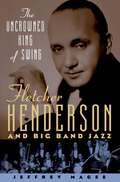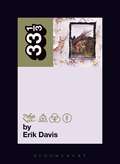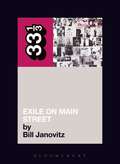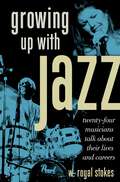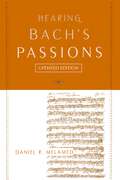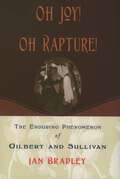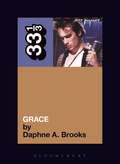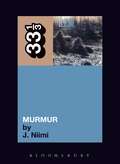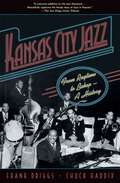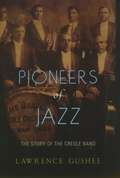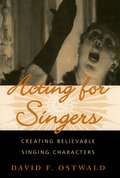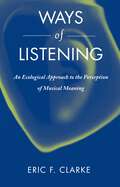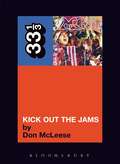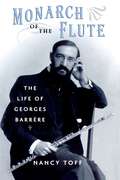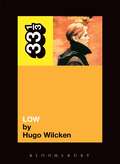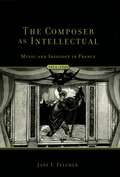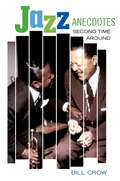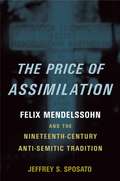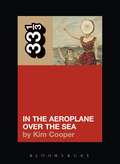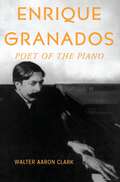- Table View
- List View
Electric Folk: The Changing Face of English Traditional Music
by Britta SweersIn the 1960s and 1970s, a number of British musicians rediscovered traditional folk ballads, fusing the old melodies with rock, jazz, and blues styles to create a new genre dubbed "electric folk" or "British folk rock." This revival featured groups such as Steeleye Span, Fairport Convention, and Pentangle and individual performers like Shirley & Dolly Collins, and Richard Thompson. While making music in multiple styles, they had one thing in common: they were all based on traditional English song and dance material. These new arrangements of an old repertoire created a unique musical voice within the popular mainstream. After reasonable commercial success, peaking with Steeleye Span's Top 10 album All Around My Hat, Electric Folk disappeared from mainstream notice in the late 1970s, yet performers continue to create today. In Electric Folk: The Changing Face of English Traditional Music, Britta Sweers provides an illuminating history and fascinating analysis of the unique features of the electric folk scene, exploring its musical styles and cultural implications. Drawing on rare historical sources, contemporary music journalism, and first-hand interviews with several of electric folk's most prominent artists, Sweers argues that electric folk is both a result of the American folk revival of the early 1960s and a reaction against the dominance of American pop music abroad. Young British "folk-rockers," such as Richard Thompson and Maddy Prior, turned to traditional musical material as a means of asserting their British cultural identity. Yet, unlike many American and British folk revivalists, they were not as interested in the "purity" of folk ballads as in the music's potential for lively interaction with modern styles, instruments, and media. The book also delves into the impact of the British folk rock movement on mainstream pop, American rock music, and neighboring European countries. Ultimately, Sweers creates a richly detailed portrait of the electric folk scene--as cultural phenomenon, commercial entity, and performance style.
The Uncrowned King of Swing: Fletcher Henderson and Big Band Jazz
by Jeffrey MageeIf Benny Goodman was the "King of Swing," then Fletcher Henderson was the power behind the throne. Now Jeffrey Magee offers a fascinating account of Henderson's musical career, throwing new light on the emergence of modern jazz and the world that created it. Drawing on an unprecedented combination of sources, including sound recordings and hundreds of scores that have been available only since Goodman's death, Magee illuminates Henderson's musical output, from his early work as a New York bandleader, to his pivotal role in building the Kingdom of Swing. He shows how Henderson, standing at the forefront of the New York jazz scene during the 1920s and '30s, assembled the era's best musicians, simultaneously preserving jazz's distinctiveness and performing popular dance music that reached a wide audience. Magee reveals how, in Henderson's largely segregated musical world, black and white musicians worked together to establish jazz, how Henderson's style rose out of collaborations with many key players, how these players deftly combined improvised and written music, and how their work negotiated artistic and commercial impulses. Whether placing Henderson's life in the context of the Harlem Renaissance or describing how the savvy use of network radio made the Henderson-Goodman style a national standard, Jeffrey Magee brings to life a monumental musician who helped to shape an era. "An invaluable survey of Henderson's life and music." --Don Heckman, Los Angeles Times "Magee has written an important book, illuminating an era too often reduced to its most familiar names. Goodman might have been the King of Swing, but Henderson here emerges as that kingdom's chief architect." --Boston Globe "Excellent.... Jazz fans have waited 30 years for a trained musicologist...to evaluate Henderson's strengths and weaknesses and attempt to place him in the history of American music." --Will Friedwald, New York Sun
Led Zeppelin's Led Zeppelin IV (33 1/3)
by Erik DavisIn this wickedly entertaining and thoroughly informed homage to one of rock music's towering pinnacles, Erik Davis investigates the magic-black or otherwise-that surrounds this album. Carefully peeling the layers from each song, Davis reveals their dark and often mystical roots-and leaves the reader to decide whether [FOUR SYMBOLS] is some form of occult induction or just an inspired, brilliantly played rock album.Excerpt:Stripping Led Zeppelin's famous name off the fourth record was an almost petulant attempt to let their Great Work symbolically stand on its own two feet. But the wordless jacket also lent the album charisma. Fans hunted for hidden meanings, or, in failing to find them, sensed a strange reflection of their own mute refusal to communicate with the outside world. This helped to create one of the supreme paradoxes of rock history: an esoteric megahit, a blockbuster arcanum. Stripped of words and numbers, the album no longer referred to anything but itself: a concrete talisman that drew you into its world, into the frame. All the stopgap titles we throw at the thing are lame: Led Zeppelin IV, [Untitled], Runes, Zoso, Four Symbols. In an almost Lovecraftian sense, the album was nameless, a thing from beyond, charged with manna. And yet this uncanny fetish was about as easy to buy as a jockstrap.
The Rolling Stones' Exile on Main Street (33 1/3)
by Bill JanovitzTracing the creation of Exile on Main Street from the original songwriting done while touring America through the final editing in Los Angeles, Bill Janovitz explains how an album recorded by a British band in a villa on the French Riviera is pure American rock & roll. Looking at each song individually, Janovitz unveils the innovative recording techniques, personal struggles, and rock & roll mythmaking that culminated in this pivotal album.
Growing up with Jazz: Twenty Four Musicians Talk About Their Lives and Careers
by W. Royal StokesA jazz writer for three decades, W. Royal Stokes has a special talent for capturing the initial spark that launches a musician's career. In Growing Up With Jazz , he has interviewed twenty-four instrumentalists and singers who talk candidly about the early influences that started them on the road to jazz and where that road has taken them. Stokes offers a kaleidoscopic look at the jazz scene, featuring musicians from a dazzling array of backgrounds. Ray Gelato recalls the life of a working class youth in London, Patrizia Scascitelli recounts being a child prodigy in Rome who became the first woman of Italian jazz, and Billy Taylor tells about his childhood in Washington, DC, where his grandfather was a Baptist minister and his father a dentist--and everyone in the family seemed well trained in music. Perhaps most exotic is Luluk Purwanto, an Indonesian violinist who as a child listened to gamelan music in the morning and took violin lessons in the afternoon (on an instrument so expensive she didn't dare quit). For some, the flame burned bright at an early age. Jane Monheit sang before she could speak and was set on a musical career by age eight. Lisa Sokolov played classical piano, sang opera and choral music, and was in a jazz band--all by high school. But Carol Sudhalter, though born into a very musical family ("a Bix Beiderbecke family"), was a botany major at Smith, and only became a serious musician after college, quitting a government job to study the flute and saxophone in Italy. From Art Blakey to Claire Daly to Don Byron, here are the compelling stories of two dozen top musicians finding their way in the world of jazz.
Understanding French Verse: A Guide for Singers
by David HunterUnderstanding French Verse: A Guide for Singers explains the formal structure of the French language and sets out the basics of French versification, using examples drawn from a wide range of well-known song settings. In clear and concise style, it explains the Alexandrine meter typically used in French-language poetry, how to distinguish different meters by counting syllables, how to identify stresses and rhyme in French verse, and ultimately, how to enhance the interpretation and enjoyment of the melodie . The book also offers valuable resources, including a brief history of French versification, detailed analysis of several poems, a glossary of technical terms, and suggestions for further reading. While other books help singers with French diction, or offer translations of French texts, no other book helps a singer understand the meaning behind what they are singing. Understanding French Verse is an essential tool for singers, accompanists, and other musicians who want to understand more about the French texts with which they are working.
Hearing Bach's Passions
by Daniel R. MelamedJohann Sebastian Bach's two surviving passions--St. John and St. Matthew--are an essential part of the modern repertory, performed regularly both by professional ensembles and amateur groups. These large, complex pieces are well loved, but due to our distance from the original context in which they were performed, questions and problems emerge. Bach scholar Daniel Melamed examines the issues we encounter when we hear the passions performed today, and offers unique insight into Bach's passion settings. Rather than providing a movement-by-movement analysis, Melamed uses the Bach repertory to introduce readers to some of the intriguing issues in the study and performance of older music, and explores what it means to listen to this music today. For instance, Bach wrote the passions for a particular liturgical event at a specific time and place; we hear them hundreds of years later, often a world away and usually in concert performances. They were performed with vocal and instrumental forces deployed according to early 18th-century conceptions; we usually hear them now as the pinnacle of the choral/orchestral repertory, adapted to modern forces and conventions. In Bach's time, passion settings were revised, altered, and tampered with both by their composers and by other musicians who used them; today we tend to regard them as having fixed texts to be treated mith respect. Their music was sometimes recycled from other compositions or reused itself for other purposes; we have trouble imagining the familiar material of Bach's passion settings in any other guise. Melamed takes on these issues, exploring everything from the sources that transmit Bach's passion settings today to the issues surrounding performance practice (including the question of the size of Bach's ensemble). He delves into the passions as dramatic music, examines the problem of multiple versions of a work and the reconstruction of lost pieces, explores the other passions in Bach's performing repertory, and sifts through the puzzle of authorship. Highly accessible to the non-specialist, the book assumes no technical musical knowledge and does not rely on printed musical examples. Based on the most recent scholarship and using lucid prose, the book opens up the debates surrounding this repertory to music lovers, choral singers, church musicians, and students of Bach's music.
Oh Joy! Oh Rapture!: The Enduring Phenomenon of Gilbert and Sullivan
by Ian BradleyIn Oh Joy! Oh Rapture! expert and enthusiast Ian Bradley explores the world of Gilbert and Sullivan over the last four and a half decades, looking at the way this "phenomenon" is passed from generation to generation. Taking as his starting point the expiry of copyright on the opera libretti at the end of 1961 and using fascinating hitherto unpublished archive material, Bradley reveals the extraordinary story of the last years of the old D'Oyly Carte Opera Company, the guardian of Savoy tradition for over a hundred years, and the troubled history of its successor. He explores the rich vein of parodies, spoofs, and spin-offs of the songs, as well as their influence on twentieth century lyricists and composers. He analyzes professional productions across the world, looks at the unique place of G&S in schools, colleges, and universities, and lovingly explores the culture of amateur performance. He also uncovers the largely male world of the obsessive fans, those collecting memorabilia, the myriad magazines, journals, websites, and festivals devoted to G&S, and the arcane interests of some of the faithful "inner brotherhood."
Elvis Costello's Armed Forces (33 1/3)
by Franklin BrunoThirty-Three and a Third is a series of short books about critically acclaimedand much-loved albums of the past 40 years. Over 50,000 copies have been sold!"Passionate, obsessive, and smart." -Nylon"...an inspired new series of short books about beloved works of vinyl." -DetailsFranklin Bruno's writing about music has appeared inthe Village Voice, Salon, LA Weekly, and Best MusicWriting 2003 (Da Capo). He has a Ph.D. in Philosophyfrom UCLA, and his musical projects include Tempting:Jenny Toomey Sings the Songs of Franklin Bruno(Misra) and A Cat May Look At A Queen (AbsolutelyKosher), a solo album. He lives in Los Angeles.
Jeff Buckley's Grace (33 1/3)
by Daphne A. BrooksThe power and influence of Grace increases with each passing year. Here, Daphne Brooks traces Jeff Buckley's fascinating musical development through the earliest stages of his career, up to the release of the album. With access to rare archival material, Brooks illustrates Buckley's passion for life and hunger for musical knowledge, and shows just why he was such a crucial figure in the American music scene of the 1990s.EXCERPT:Jeff Buckley was piecing together a contemporary popular music history for himself that was steeped in the magic of singing. He was busy hearing how Dylan channeled Billie Holiday in Blonde On Blonde and how Robert Plant was doing his best to sound like Janis Joplin on early Led Zeppelin recordings. He was thinking about doo-wop and opera and Elton John and working at developing a way to harness the power of the voice...In the process, he was re-defining punk and grunge "attitude" itself by rejecting the ambivalent sexual undercurrents of those movements, as well as Led Zeppelin's canonical "cock rock" kingdom that he'd grown up adoring. He was forging a one-man revolution set to the rhythms of New York City and beyond. And he was on the brink of recording his elegant battle in song for the world to hear.
R.E.M.'s Murmur (33 1/3)
by J. NiimiR.E.M.'s debut album, released in 1983, was so far removed from the prevailing trends of American popular music that it still sounds miraculous and out of time today. J. Niimi tells the story of the album's genesis - with fascinating input from Don Dixon and Mitch Easter. He also investigates Michael Stipe's hypnotic, mysterious lyrics, and makes the case for Murmur as a work of Southern Gothic art.
Singing Schumann: An Interpretive Guide for Performers
by Richard MillerSinging Schumann is likely to become the standard introduction to some of the best-loved songs in the singer's repertoire. Written by a distinguished performer and internationally known teacher, the book offers astute, practical advice for bringing Robert Schumann's Lieder to life in performance. Richard Miller guides the reader through the interpretation of all of Schumann's solo and duet songs, drawing thoroughly on Schumann's compositional style and its historical background. In addition to covering the "familiar forty"--the much-performed songs Schumann composed in and around 1840 while trying to win the hand of Clara Wieck--Miller takes an in-depth look at the lesser known early and later songs. In particular, he focuses on the rich and varied repertoire of Schumann's later years, challenging the conventional view that these works reflect a decline in the composer's creative powers. Singing Schumann begins with an overview of Schumann as a song composer and then proceeds to survey the entire repertoire, song by song. It features the well-known cycles, including the Eichendorff Liederkreis, Frauenliebe und -leben, and Dichterliebe, as well as the Liederalbum für die Jugend and settings of texts by Goethe, Burns, Rückert, and Kulmann. Using numerous musical examples, Miller uncovers Schumann's characteristic compositional devices and describes his novel and experimental approaches to the interpretation of texts, often achieved through exceptionally colorful keyboard accompaniments. Musically sensitive and eminently readable, Singing Schumann is an invaluable guide for teachers, coaches, pianists, and singers.
Kansas City Jazz: From Ragtime to Bebop--A History
by Frank Driggs Chuck HaddixThere were but four major galaxies in the early jazz universe, and three of them--New Orleans, Chicago, and New York--have been well documented in print. But there has never been a serious history of the fourth, Kansas City, until now. In this colorful history, Frank Driggs and Chuck Haddix range from ragtime to bebop and from Bennie Moten to Charlie Parker to capture the golden age of Kansas City jazz. Readers will find a colorful portrait of old Kaycee itself, back then a neon riot of bars, gambling dens and taxi dance halls, all ruled over by Boss Tom Pendergast, who had transformed a dusty cowtown into the Paris of the Plains. We see how this wide-open, gin-soaked town gave birth to a music that was more basic and more viscerally exciting than other styles of jazz, its singers belting out a rough-and-tumble urban style of blues, its piano players pounding out a style later known as "boogie-woogie." We visit the great landmarks, like the Reno Club, the "Biggest Little Club in the World," where Lester Young and Count Basie made jazz history, and Charlie Parker began his musical education in the alley out back. And of course the authors illuminate the lives of the great musicians who made Kansas City swing, with colorful profiles of jazz figures such as Mary Lou Williams, Big Joe Turner, Jimmy Rushing, and Andy Kirk and his "Clouds of Joy." Here is the definitive account of the raw, hard-driving style that put Kansas City on the musical map. It is a must read for everyone who loves jazz or American music history.
Pioneers of Jazz: The Story of the Creole Band
by Lawrence GusheeThanks to the pioneering tours of the Creole Band, jazz began to be heard nationwide on the vaudeville stages of America from 1914 to 1918. This seven-piece band toured the country, exporting for the first time the authentic jazz strains that had developed in New Orleans at the start of the 20th century. The band's vaudeville routines were deeply rooted in the minstrel shows and plantation cliches of American show business in the late 19th century, but its instrumental music was central to its performance and distinctive and entrancing to audiences and reviewers. Pioneers of Jazz reveals at long last the link between New Orleans music and the jazz phenomenon that swept America in the 1920s. While they were the first important band from New Orleans to attain national exposure, The Creole Band has not heretofore been recognized for its unique importance. But in his monumental, careful research, jazz scholar Lawrence Gushee firmly establishes the group's central role in jazz history. Gushee traces the troupe's activities and quotes the reaction of critics and audiences to their first encounters with this new musical phenomenon. While audiences often expected (and got) a kind of minstrel show, the group transcended expectations, taking pride in their music and facing down the theatrical establishment with courage. Although they played the West Coast and Canada, most of their touring centered in the heartland. Most towns of any size in Iowa, Illinois, and Indiana heard them, often repeatedly, and virtually all of their appearances were received with wild enthusiasm. After four years of nearly incessant traveling, members of the band founded or joined groups in Chicago's South Side cabaret scene, igniting the craze for hot New Orleans music for which the Windy City was renowned in the early 1920s. The best-known musicians in the group--cornetist Freddie Keppard, clarinetist Jimmy Noone and string bassist Bill Johnson--would play a significant role in jazz, becoming famous for recordings in the 1920s. Gushee effectively brings to life each member of the band and discusses their individual contributions, while analyzing the music with precision, skillful and exacting documentation. Including many never before published photos and interviews, the book also provides an invaluable and colorful look at show business, especially vaudeville, in the 1910s. While some of the first jazz historians were aware of the band's importance, attempts to locate and interview surviving members (three died before 1935) were sporadic and did little or nothing to correct the mostly erroneous accounts of the band's career. The jazz world has long known about Gushee's original work on this previously neglected subject, and the book represents an important event in jazz scholarship. Pioneers of Jazz brilliantly places this group's unique importance into a broad cultural and historical context, and provides the crucial link between jazz's origins in New Orleans and the beginning of its dissemination across the country.
Acting for Singers: Creating Believable Singing Characters
by David F. OstwaldWritten to meet the needs of thousands of students and pre-professional singers participating in production workshops and classes in opera and musical theater, Acting for Singers leads singing performers step by step from the studio or classroom through audition and rehearsals to a successful performance. Using a clear, systematic, positive approach, this practical guide explains how to analyze a script or libretto, shows how to develop a character building on material in the score, and gives the singing performer the tools to act believably. More than just a "how-to" acting book, however, Acting for Singers also addresses the problems of concentration, trust, projection, communication, and the self-doubt that often afflicts singers pursuing the goal of believable performance. Part I establishes the basic principles of acting and singing together, and teaches the reader how to improvise as a key tool to explore and develop characters. Part II teaches the singer how to analyze theatrical work for rehearsing and performing. Using concrete examples from Carmen and West Side Story, and imaginative exercises following each chapter, this text teaches all singers how to be effective singing actors.
Ways of Listening: An Ecological Approach to the Perception of Musical Meaning
by Eric ClarkeIn recent years, many psychologists and cognitive scientists have published their views on the psychology of music. Unfortunately, this scientific literature has remained inaccessible to musicologists and musicians, and has neglected their insights on the subject. In Ways of Listening, musicologist Eric Clarke explores musical meaning, music's critical function in human lives, and the relationship between listening and musical material. Clarke outlines an "ecological approach" to understanding the perception of music. The way we hear and understand music is not simply a function of our brain structure or of the musical "codes" given to us by culture, Clarke argues. Instead, cognitive, psychoacoustical, and semiotic issues must be considered within the physical and social contexts of listening. In essence, Clarke adapts John Gibson's influential ecological theory of perception to the complex process of perceiving music. In addition to making a theoretical argument, the author offers a number of case studies to illustrate his concept. For example, he analyzes the experience of listening to Jimi Hendrix's performance of the Star Spangled Banner at Woodstock in 1969. Clarke examines how Hendrix's choice of instrument and venue, use of distortion, and the political climate in which he performed all had an impact on his audience's perception of the anthem. A complex convergence of broad cultural contexts and specific musical features - the entire "ecology" of the listening experience - is responsible for this performance's impact. Including both the best psychological research and careful musicological scholarship, Clarke's book offers the most complex and insightful perspective on musical meaning to date. It will be of interest to musicologists, musicians, psychologists, and scholars of aesthetics.
MC5's Kick Out the Jams (33 1/3)
by Don McLeeseWhen the Motor City 5 stormed the stage, the band combined the kinetic flash of James Brown on acid with the raw musical dynamics of the Who gone berserk. It's a unique band that can land itself on the cover of Rolling Stone a month before the release of its debut album and then be booted from its record contract just a few months later. Rock had never before seen the likes of the MC5 and never will again. Many of us who were floored by the 5 in concert were convinced that this was the most transcendently pulverizing rock we would ever experience, while many more who heard or read about the band dismissed the 5 as a caricature, a fraud, White Panther bozos play-acting at revolution. There was always plenty of humor to the 5-visionary knuckleheads-though the question was whether they were in on the joke. Frequently ridiculed during their short career, they've since been hailed as a primal influence on everything from punk to metal to Rage Against the Machine to the Detroit populist resurgence of the White Stripes, Kid Rock and Eminem.
Monarch of the Flute: The Life of Georges Barrère
by Nancy ToffGeorges Barrère (1876-1944) holds a preeminent place in the history of American flute playing. Best known for two of the landmark works that were written for him--the Poem of Charles Tomlinson Griffes and Density 21.5 by Edgard Varèse--he was the most prominent early exemplar of the Paris Conservatoire tradition in the United States and set a new standard for American woodwind performance. Barrère's story is a musical tale of two cities, and this book uses his life as a window onto musical life in Belle Epoque Paris and twentieth-century New York. Recurrent themes are the interactions of composers and performers; the promotion of new music; the management, personnel, and repertoire of symphony orchestras; the economic and social status of the orchestral and solo musician, including the increasing power of musicians' unions; the role of patronage, particularly women patrons; and the growth of chamber music as a professional performance medium. A student of Paul Taffanel at the Paris Conservatoire, by age eighteen Barrère played in the premiere of Debussy's Prelude to the Afternoon of a Faun. He went on to become solo flutist of the Concerts Colonne and to found the Sociètè Moderne d'Instruments á Vent, a pioneering woodwind ensemble that premiered sixty-one works by forty composers in its first ten years. Invited by Walter Damrosch to become principal flute of the New York Symphony in 1905, he founded the woodwind department at the Institute of Musical Art (later Juilliard). His many ensembles toured the United States, building new audiences for chamber music and promoting French repertoire as well as new American music. Toff narrates Barrère's relationships with the finest musicians and artists of his day, among them Isadora Duncan, Yvette Guilbert, André Caplet, Paul Hindemith, Albert Roussel, Wallingford Riegger, and Henry Brant. The appendices of the book, which list Barrère's 170 premieres and the 50 works dedicated to him, are a resource for a new generation of performers. Based on extensive archival research and oral histories in both France and the United States, this is the first biography of Barrère.
David Bowie's Low (33 1/3)
by Hugo WilckenLos Angeles, 1976. David Bowie is holed up in his Bel-Air mansion, drifting into drug-induced paranoia and confusion. Obsessed with black magic and the Holy Grail, he's built an altar in the living room and keeps his fingernail clippings in the fridge. There are occasional trips out to visit his friend Iggy Pop in a mental institution. His latest album is the cocaine-fuelled Station To Station (Bowie: "I know it was recorded in LA because I read it was"), which welds R&B rhythms to lyrics that mix the occult with a yearning for Europe, after three mad years in the New World.Bowie has long been haunted by the angst-ridden, emotional work of the Die Brucke movement and the Expressionists. Berlin is their spiritual home, and after a chaotic world tour, Bowie adopts this city as his new sanctuary. Immediately he sets to work on Low, his own expressionist mood-piece.
The Composer As Intellectual: Music and Ideology in France, 1914-1940
by Jane F. FulcherIn The Composer as Intellectual, musicologist Jane Fulcher reveals the extent to which leading French composers between the World Wars were not only aware of but also engaged intellectually and creatively with the central political and ideological issues of the period. Employing recent sociological and historical insights, she demonstrates the extent to which composers, particularly those in Paris since the Dreyfus Affair, considered themselves and were considered to be intellectuals, and interacted closely with intellectuals in other fields. Their consciousness raised by the First World War and the xenophobic nationalism of official culture, some joined parties or movements, allying themselves with and propagating different sets of cultural and political-social goals. Fulcher shows how these composers furthered their ideals through the specific language and means of their art, rejecting the dominant cultural exclusions or constraints of conservative postwar institutions and creatively translating their cultural values into terms of form and style. This was not only the case with Debussy in wartime, but with Ravel in the twenties, when he became a socialist and unequivocally refused to espouse a narrow, exclusionary nationalism. It was also the case with the group called "Les Six," who responded culturally in the twenties and then politically in the thirties, when most of them supported the programs of the Popular Front. Others could not be enthusiastic about the latter and, largely excluded from official culture, sought out more compatible movements or returned to the Catholic Church. Like many French Catholics, they faced the crisis of Catholicism in the thirties when the church not only supported Franco, but Mussolini's imperialistic aggression in Ethiopia. While Poulenc embraced traditional Catholicism, Messiaen turned to more progressive Catholic movements that embraced modern art and insisted that religion must cross national and racial boundaries. Fulcher demonstrates how closely music had become a field of clashing ideologies in this period. She shows also how certain French composers responded, and how their responses influenced specific aspects of their professional and stylistic development. She thus argues that, from this perspective, we can not only better understand specific aspects of the stylistic evolution of these composers, but also perceive the role that their art played in the ideological battles and in heightening cultural-political awareness of their time.
Puccini: His Life and Works (Master Musicians Series)
by Julian BuddenJulian Budden, one of the world's foremost scholars of Italian opera and author of a monumental three-volume study of Verdi's works, now offers music lovers a major new biography of one of the giants of Italian opera, Giacomo Puccini. Blending astute musical analysis with a colorful account of Puccini's life, here is an illuminating look at some of the most popular operas in the repertoire, including Manon Lescaut, La Boheme, Tosca, Madama Butterfly, and Turandot. Budden provides an illuminating look at the process of putting an opera together, the cut-and-slash of nineteenth-century Italian opera--the struggle to find the right performers for the debut of La Boheme, Puccini's anxiety about completing Turandot (he in fact died of cancer before he did so), his animosity toward his rival Leoncavallo (whom he called Leonasino or "lion-ass"). Budden provides an informative analysis of the operas themselves, examining the music act by act. He highlights, among other things, the influence of Wagner on Puccini--alone among his Italian contemporaries, Puccini followed Wagner's example in bringing the motif into the forefront of his narrative, sometimes voicing the singer's unexpressed thoughts, sometimes sending out a signal to the audience of which the character is unaware. And Budden also paints an intriguing portrait of Puccini the man--talented but modest, a man who had friends from every walk of life: shopkeepers, priests, wealthy landowners, fellow artists. Affable, well mannered, gifted with a broad sense of fun, he rarely failed to charm all who met him. A new volume in the esteemed Master Musicians series, Puccini offers a masterful portrait of this beloved Italian composer.
Jazz Anecdotes: Second Time Around
by Bill CrowWhen jazz musicians get together, they often delight one another with stories about the great, or merely remarkable, players and singers they've worked with. One good story leads to another until someone says, "Somebody ought to wrie these down!" With Jazz Anecdotes, somebody finally has. Drawing on a rich verbal tradition, bassist and jazz writer Bill Crow has culled stories from a wide variety of sources, including interviews, biographies and a remarkable oral history collection, which resides at the Institute of Jazz Studies at Rutgers University, to paint fascinating and very human portraits of jazz musicians. Organized around general topics--teaching and learning, life on the road, prejudice and discrimination, and the importance of a good nickname--Jazz Anecdotes shows the jazz world as it really is. In this fully updated edition, which contains over 150 new anecdotes and new topics like Hiring and Firing, Crow regales us with new stories of such jazz greats as Benny Goodman, Chet Baker, Ravi Coltrane, Buddy Rich and Paul Desmond. He offers extended sections on old favorites--Louis Armstrong, Duke Ellington, Coleman Hawkins and Lester Young, and the fabulous Eddie Condon, who seems to have lived his entire life with the anecdotist in mind. With its unique blend of sparkling dialogue and historical and social insight, Jazz Anecdotes will delight anyone who loves a good story. It offers a fresh perspective on the joys and hardships of a musician's life as well as a rare glimpse of the personalities who created America's most distinctive music.
The Price of Assimilation: Felix Mendelssohn and the Nineteenth-Century Anti-Semitic Tradition
by Jeffrey S. SposatoMost scholars since World War Two have assumed that composer Felix Mendelssohn Bartholdy (1809-1847) maintained a strong attachment to Judaism throughout his lifetime. As these commentators have rightly noted, Mendelssohn was born Jewish and did not convert to Protestantism until age seven, his grandfather was the famous Jewish reformer and philosopher Moses Mendelssohn, and his music was banned by the Nazis, who clearly viewed him as a Jew. Such facts tell only part of the story, however. Through a mix of cultural analysis, biographical study, and a close examination of the libretto drafts of Mendelssohn's sacred works, The Price of Assimilation provides dramatic new answers to the so-called "Mendelssohn Jewish question." Sposato demonstrates how Mendelssohn's father, Abraham, worked to distance the family from its Jewish past, and how Mendelssohn's reputation as a composer of Christian sacred music was threatened by the reverence with which German Jews viewed his family name. In order to prove the sincerity of his Christian faith to both his father and his audiences, Mendelssohn aligned his early sacred works with a nineteenth-century anti-Semitic musical tradition, and did so more fervently than even his Christian collaborators required. With the death of Mendelssohn's father and the near simultaneous establishment of the composer's career in Leipzig in 1835, however, Mendelssohn's fear of his background began to dissipate, and he began to explore ways in which he could prove the sincerity of his faith without having to publicly disparage his Jewish heritage.
Neutral Milk Hotel's In the Aeroplane Over the Sea (33 1/3)
by Kim CooperOf all the recordings to emerge from the Athens-via-Denver collective called Elephant 6, Neutral Milk Hotel's second album is the one that has worked its way under the most skins. Magnet magazine named it the best album of the 1990s, and Creative Loafing recently devoted a cover story to one fan's quest to understand why band leader Jeff Mangum dropped outof sight soon after Aeroplane's release. The record sells steadily to an audience that finds it through word of mouth. Weird, beautiful, absorbing, difficult, In The Aeroplane Over the Seais a surrealist text loosely based on the life, suffering and reincarnation of Anne Frank, with guest appearances from a pair ofSiamese twins menaced by the cold and carnivores, a two-headed boy bobbing in a jar, anthropomorphic vegetables and a variety of immature erotic horrors. Mangum sings his dreamlike narratives with a dreamer's intensity, his creaky, off key voice occasionally breaking as he struggles to complete each dense couplet. The music is like nothing else in the 90s indie underground: a psychedelic brass band, its members self-taught, forging polychromatic washes of mood and tribute. The songs stick to one narrow key, the images repeat and circle back, and to listen is to be absorbed into a singular, heart-rending vision.
Enrique Granados: Poet of the Piano
by Walter Aaron ClarkEnrique Granados (1867-1916) is one of the most compelling figures of the late-Romantic period in music. During his return voyage to Spain after the premiere of his opera Goyescas at New York's Metropolitan Opera in 1916, a German submarine torpedoed the ship on which he and his wife were sailing, and they perished in the waters of the English Channel. His death was mourned on both sides of the Atlantic as a stunning loss to the music world, for he had died at the pinnacle of his career, and his late works held the promise of greater things to come. Granados was among the leading pianists of his time, and his eloquence at the keyboard inspired critics to dub him the "poet of the piano." In Enrique Granados: Poet of the Piano, Walter Aaron Clark offers the first substantive study in English of this virtuoso pianist, composer, and music pedagogue. While providing detailed analyses of his major works for voice, piano, and the stage, Clark argues that Granados's art represented a unifying presence on the cultural landscape of Spain during a period of imperial decline, political unrest, and economic transformation. Drawing on newly discovered documents, Clark explores the cultural spheres in which Granados moved, particularly of Castile and Catalonia. Granados's best-known music was inspired by the art of Francisco Goya, especially the Goyescas suite for solo piano that became the basis for the opera. These pieces evoked the colorful and dramatic world that Goya inhabited and depicted in his art. Granados's fascination with Goya's Madrid set him apart from fellow nationalists Albéniz and Falla, who drew their principal inspiration from Andalusia. Though he was resolutely apolitical, Granados's attraction to Castile antagonized some Catalan nationalists, who resented Castilian domination. Yet Granados also made important contributions to Catalan musical theater and was a prominent figure in the modernist movement in Barcelona. Clark also explores the personal pressures that shaped Granados's music. His passionate affair with a wealthy socialite created domestic tensions, but it was also a source of inspiration for Goyescas. Persistent financial difficulties forced him to devote time to teaching at the expense of composition, though as a result Granados made considerable contributions to piano pedagogy and music education in Barcelona through the music academy he founded there. While Granados's tragic and early demise casts a pall over his life story, Clark ultimately reveals an artist of remarkable versatility and individuality and sheds new light on his enduring significance.

